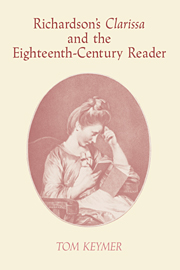Book contents
2 - Casuistry in Clarissa The first instalment, December 1747
Published online by Cambridge University Press: 24 October 2009
Summary
On ne peut assurément se défendre d'estimer beaucoup, et même de respecter l'héroïne de ce roman; et cependant Clarisse a fait à peu près la plus grande faute qu'une fille puisse faire, puisqu'elle a fui de la maison paternelle avec son séducteur.
Laclos, ‘Des Femmes et de leur éducation’Richardson and casuistry
Clarissa is not the only book about freedom and authority to date from 1748. In the same year, Richardson read in manuscript
‘A Dialogue between a Father and a Daughter,’ very sprightly; a little sprinkling of something better in it, but very sparingly sprinkled; as if the author were afraid, that his mind should be thought as antique as his body. – Calculated to reconcile fatherly authority with filial obedience: (so he says.) – But I think, to level the former, and throw down distinction.
His complaints to the dialogue's author, Colley Cibber, were no less frank, focusing in particular on the undutiful character of the daughter. At Speaker Onslow's suggestion he even began a written critique. He pursued it, however, no further than the opening page of the manuscript, and despite Cibber's willingness to alter two or three passages (‘but’, he complained,‘… not for the better’) he could not be persuaded to continue. Instead he envisaged a more formal, ventriloquised response, to be produced should Cibber publish. ‘If he does’, he told Sarah Wescomb, ‘I had a good mind that Miss Howe (who is pert enough of conscience to her mamma; Clarissa you know is dead) should answer it.’
When the piece appeared, within the year, as The Lady' Lecture, A Theatrical Dialogue, between Sir Charles Easy and His Mariageable Daughter. Being an Attempt To Engage Obedience by Filial Liberty,, it showed little evidence of Cibber's two or three Richardsonian alterations.
- Type
- Chapter
- Information
- Richardson's 'Clarissa' and the Eighteenth-Century Reader , pp. 85 - 141Publisher: Cambridge University PressPrint publication year: 1992
- 1
- Cited by

